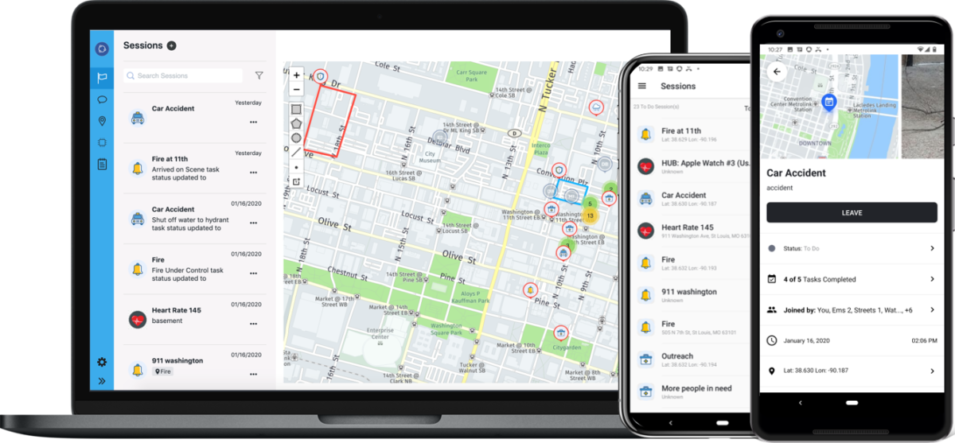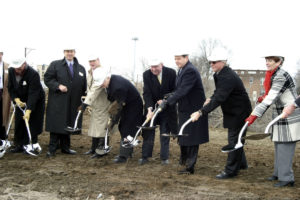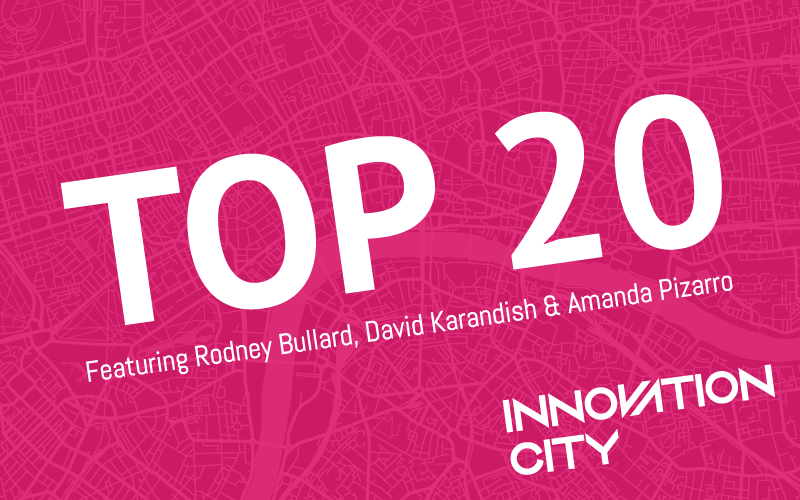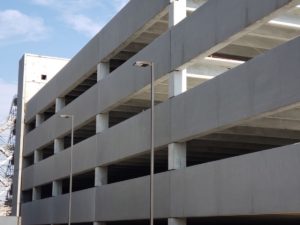
St. Louis Mayoral Tech Town Hall Brings Candidates to Venture Cafe
Last Thursday, February 23, eight mayoral candidates convened at Cortex during Venture Cafe for a St. Louis Mayoral Town Hall focused on technology and innovation. Here were the main takeaways.
On Thursday, February 23, eight mayoral candidates convened at Cortex during Venture Cafe for a St. Louis Mayoral Town Hall focused on technology and innovation.
Moderated by Kelly Hamilton, Publisher of EQ, and Alex Ihnen, Publisher of nextSTL and Executive Director of Dutchtown South Community Corporation, the town hall provided the candidates with the opportunity to field questions exposing a variety of distinctive perspectives on how the Mayor can influence innovation and leverage technology in the City of St. Louis.
Candidates who participated in the Town Hall included:
- Jeffrey Boyd, 22nd Ward Alderman
- Kacey Cordes, VP of US Bancorp Community Development Corporation
- Antonio French, 21st Ward Alderman
- Tishaura Jones, Treasurer of the City of St. Louis
- Lyda Krewson, 28th Ward Alderwoman
- Jimmie Matthews
- Lewis Reed, President of the Board of Aldermen,
- Reverend Larry Rice
Support innovation, bring jobs to STL
The candidates were asked, “How do you believe a mayor should support innovation to bring great jobs to the city and attract the best and brightest to St. Louis? And what is your plan to do that?”
From innovating at City Hall to funding existing training programs, the candidates shared a broad spectrum of ideas for how to promote St. Louis’ innovation ecosystem.
Kacey Cordes kicked off the conversation by sharing an “Innovation begins at City Hall” model as one that could work in St. Louis.
She said, “I point to what’s going on in Kansas City. Mayor Sly James is bringing innovation to City Hall by enabling innovators to get access to systems at City Hall, which allows them to develop programs that can be piloted using the urban fabric as a laboratory. This is a way to create a win-win situation for both the innovation community and for the city.”
Lewis Reed continued along similar lines. He said, “If we want people to buy more electric cars in the city, one of the things we can do is begin to transition our fleet services over to electric cars.”
“Then you’ll have the supplies and everything you need for people to be able to then go out and buy electric cars because you have places for them to plug in and charge. If we want more programmers in the city, we begin to invest in that area and begin to work with recruiters and people to bring them to the City of St. Louis and encourage our entrepreneurs to invest and to work within the community to help bring up other young programmers.”
Tishaura Jones, like Cordes, believes that neighboring cities may have some good ideas that are encouraging innovation and would benefit St. Louis. She said, “I am not in favor of reinventing the wheel.”
“A lot of times these are problems that have already been solved and things that have already been invented. Again, bring them to our environment, tweak them for our environment, and let them roll.”
Jimmie Matthews asserted that innovation begins at home and at school and that the mayor’s influence should follow that pattern. He said, “I think innovation starts at the top. In your home, who’s the innovator? The parent.”
“So your parents are who encouraged you to become great. So, if you have someone at the top that thinks out of the box, not the people that have been in the box, sitting in the Mayor’s Office.”
“I haven’t been in the box, I have been outside. If you raise people from the bottom, and you’re sitting at the top, they’ll go up too.”
“So what we want to be able to do is raise the least of us to the standards where we want them to come. We teach our students in the classroom before you graduate you will know Calculus, Science and technology.”
“You have to be innovative in the classroom. My students knew how to rap, so I taught them to write me raps.”

Limits on subsidies
The candidates were asked, “How much would you subsidize projects like Cortex, and by doing so, how would it impact distressed neighborhoods such as those on the North and South sides?”
Candidate responses included critiques of and praise for historic and recent subsidized projects, and a desire for a plan that would allow the city rather than developers to drive development. Boyd and Cordes suggested a comprehensive city plan is critical for determining whether or not a project should be subsidized.
Boyd said, “Cortex is near maximum on needing incentives. The reason we have TIFs (tax increment financing) and tax abatements is to support our distressed communities such as the communities that are both north and south, communities like the one I live in.”
“And I want to put a strategic plan across the whole city in which we actually map out the whole city and we say look, developer, in this area, this is the maximum amount of incentives that you will get. So that when developers come in, we stop reacting to their plans, and we make them react to our plans.”
“Enough is enough. And they will not come to neighborhoods that are distressed when we continue to do what we’re doing in the central corridor with our tax incentives.”
Cordes elaborated on Boyd’s point.
She said, “I’ve had experience working on community development investment projects throughout the country and in just about every other city the developer is responding and fitting in to the city’s comprehensive plan. And if we have community engagement that really drives priorities for every single neighborhood and then calls for where we want to subsidize as a city and then hopefully soon as a region, we’ll be making better decisions.”
French suggested that, historically, some city projects have been approached properly in terms of subsidies, and some have not.
He said, “There are good TIFs and there are bad TIFs. The problem is that they have been so overly used in the central corridor and so underused in sincerely blighted areas that people are becoming frustrated and just want to throw it all out.”
“I think Cortex is a good project. Cortex was done like it should be done. It was done in phases. It is spelled out exactly how it’s going to be, and economically it makes sense for the city.”
“A bad TIF is the Paul McKee TIF (development around the National Geospacial Agency facility that will be built in North St. Louis). There is no spelling out of what’s happening in that area.”
“No one knows what is going to happen in that area in five years. That’s an example of bad development.
“I voted–and I think I’m the only one up here who continually votes against that Paul McKee project until we start making it make sense for the city. Economical sense, and in terms of our goals for the city.”
When an audience member said that without the Paul McKee project, the NGA project would not be happening, French disagreed: “That’s not true. NGA is developer-driven.”
“There are other areas where NGA could be moved to. The city decided based on the developer. The city didn’t even come up with a place to put it. They left that up to Paul McKee. This is an example of developer-driven versus city driven.”
Jones and Krewson asserted that clear-eyed, objective calculations should be made when deciding to subsidize developments. Jones said, “I remember [the Cortex development], and it was blighted. However, there are areas in the city where we have given TIFs and tax abatements that are not blighted.”
“Where the current Whole Foods is located was not blighted, in my opinion. Whole Foods would have located there anyway, even if we hadn’t given any tax subsidies. So, we need a more objective way of looking at our tax subsidies and how we award those things, and the mayor does not need to be afraid to use his or her veto pen if necessary.”
Krewson said, “Incentives are about half art and half science. The science of incentives is the numbers.”
“You’ve got to look at the numbers. And those have to make sense. But the art part of any incentives is the approach I take in the 28th ward.”
“How little can I give this developer without killing the project? Certainly if you’re north or south of the central corridor, you would give more to that developer for a project in those areas. That’s my own opinion.”
“And when you look back at The Loop, 15 years ago, there was no Moonrise, no Pageant, no Pi Pizzeria. Those projects did not exist then.”
“Now all projects are paying taxes. They did have 10 years of tax abatement, and they’re all paying full taxes now.”
“That’s what I think incentives are about. Give as little as you can, get the project down, cause now we have a very vibrant economic area.”
Rice insisted that investing in sports facilities is not the approach he would take as mayor. “I’ll tell you one thing I wouldn’t do is spend $60 million on a soccer stadium or $12 million on a football stadium.”
“I’d be trying to utilize that money to try to get a tech ecosystem in place in St. Louis, teach kids to code, get these green jobs in place. Yes, green jobs, work together with Ranken Technology, repair the buildings that we can, and use the rest for putting in the solar power and teaching people how to utilize renewable energy.”
“But let’s create jobs. And not spend it on sports. Something is wrong. And I’m an outsider and I can address that wrong and will bring about change.”

Diversity
The candidates were asked, “Many view startups and tech companies as the creations of straight, cis, able-bodied white men. As mayor, how might you encourage diversity in the industry while courting innovators and funding?”
Jeffrey Boyd would make a deeper investment in the St. Louis Agency on Training and Employment (SLATE), and work to create partnerships with corporations and support for entrepreneurs in distressed neighborhoods. He said, “Over 50% of the sales in the US are made with small businesses.”
“First, I want to adequately fund our SLATE program, which provides training for entrepreneurs. Then we partner with major corporations where entrepreneurs will have mentors.”
“And I want to provide incentives for small companies to start up in neighborhoods that are distressed like mine and Antonio French’s on the northern edge and southern part of the City of St. Louis. We have to be strategic in our thinking–and not only innovative with our technology but innovative on how we rebuild our communities.”
Kacey Cordes cited two additional programs as examples of what she would support as mayor to encourage diversity in the sector, including the recently launched Venture Cafe satellite program at LaunchCode called Venture Café Night: No Ceilings. The program focuses on how innovation is applied to civic and social issues in the region. LaunchCode‘s Mentor Center, on Delmar, is dedicated to equity, access, and diversity in technology.
She said, “That is exactly the kind of thing we need to do more of to really bring this kind of programming into neighborhoods where folks may not have been historically exposed to these topics and these channels to get involved in the entrepreneurship community.
“I also think about The Collective, which is driven by this $420,000 grant from the Kauffman Foundation in Kansas City where 12 of our entrepreneurial organizations have come together to think very deeply about how to embed racial equity into this ecosystem.”
Disrupting the status quo
The candidates were asked, ” Cities are creating great results using technology and innovation to disrupt the status quo, from tracking trash pick-up to providing micro-housing for the homeless. What would be the most disruptive things you would do as mayor?
Candidate responses had similar themes:
Fiber
All the candidates are in favor taking fuller advantage of Fiber Optic cable running under St. Louis City streets.
Reed said, “When I led the redevelopment of Washington Avenue, and they dug a trench all up and down Washington Avenue, I said ‘you know what, with part of this abandoned steam loop let’s put dark fiber all through here so that in years to come we have some capacity to build on.’ We have that all up and down Washington Avenue to be able to grow off of. We also have a lot of fiber all up and down Metrolink. So we need to now look at how we turn that into a revenue generator.”
Jones said, “St. Louis already has fiber running up under its streets and I think that that’s a source of revenue for us. And we can build that infrastructure up so we can have fiber going everywhere but also monetize that and offer it as a utility, that’s [something] that Chatanooga does. They offer high speed internet as a utility and that’s also a source of revenue. Cause right now we’re looking at a potential $20 million shortfall in our budget next fiscal year. So what we do? Two things: we increase access to internet for houses that don’t currently have access and we increase our revenue at the same time.
French said, “I have experience with the city’s fiber optic network working on our surveillance camera program and expanding it to fiber optics. The fact is that only two guys right now in the streets department deal with all the fiber in the whole city, so it is a very under-utilized resource and we need to expand that. It runs along main thoroughfares right now and we need to open that up. I would also like to see us turn some of these old public phone stations into public wi-fi areas where people can get free wi-fi, especially in areas where they don’t have a lot of internet access.
Neighborhoods
Boyd said, “In my neighborhood, we’re dealing with trying to get surveillance cameras from within the system. And in certain parts of the city we have fiber optics and in certain parts of the city we don’t. So it costs us more money to have this type of technology because we don’t have the right infrastructure.”
“And I think it’s of paramount importance that we put that infrastructure in place so that we can grow our technology companies, so it’s not a burden to have to use radio or cell phone technology in order to process data. So I’ll be looking forward to working on rebuilding our infrastructure across the whole city.
French believes investing in neighborhoods rather than large corporate projects would be not only disruptive but necessary. He said, “It’s not going to be a single project that will save the City of St. Louis.”
“The moonshot for us is something very radical, like taking care of our neighborhoods and keeping up the quality of these communities that make them places where people want to stay. We very often bet on really big ideas, mostly Downtown.”
“As if that’s going to save the city. It’s not going to save the city. What’s going to save the city is concentrating on the neighborhoods where most people live.”
“And that’s a radical idea, costs just as much probably, a billion dollars. But focusing on where people live, I think that’s where you get the most bang for your buck.”
Partnerships and Collaboration
Cordes and Krewson believe a moonshot for St. Louis would simply be getting everyone to the table to discuss a plan for the future. Cordes said, “I think this city does not do nearly enough innovative partnering with the private sector and we have an incredibly robust set of professionals and there’s actually a lot of money in this town.”
“I think it’s shipped out of town every single day. And I think if we can foster those connections and really convene people who would do projects like what Alderman Boyd often references in his ward.”
“Take Arlington Grove with hundreds of units of affordable housing. My organization participated in the financing of that, and we don’t see enough of that type of investment in St. Louis. And I think we need more of it.”
“And especially now that we have the federal designation of a promise zone. We can really command a lot better rating from the federal government on how they would give us resources to make that happen.”
Krewson said, “This seems like a moonshot for St. Louis–get everyone at the table to really think about this. Build partnerships. Get blacks at the table, get whites at the table, Hispanics at the table, young people, old people.”
“To really think about where, as a community, we want to go. I think you know something like the soccer stadium is not a moonshot.”
“That’s just something that a developer brings to us. Let’s think about as a community where we really want to go.”
“I think your question had to do with a particular project which sounds like construction to me but projects are also the brainstorming that goes on and the inclusion that people feel and the investment that people feel when they’re actually at the table.
The Mayoral Primary takes place on March 7 and election day is April 4.










